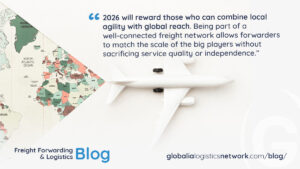The air cargo industry is no stranger to volatility. Between the disruptions of the past few years and the growing pressure for speed, sustainability, and digital transparency, freight forwarders are bracing for another year of major change. So what will 2026 bring? Let’s dive into the air freight trends in 2026 that matter most to logistics professionals and independent freight forwarders.
The big picture: Market trends to watch
Air freight is set for a year of cautious optimism. After a prolonged period of global instability from pandemic shocks to geopolitical tensions, 2026 is shaping up to be more stable, but far from predictable.
One of the defining air freight trends in 2026 will be resilient, diversified supply chains. Shippers are increasingly routing cargo away from over-congested or politically sensitive hubs. That means more direct regional air connections, growing reliance on secondary airports, and stronger demand for local partners who can move fast.
Digitalization will also play a bigger role than ever. With IATA pushing forward with full e-AWB (Electronic Air Waybill) compliance and digital cargo documentation becoming the industry standard, forwarders without digital tools will find themselves sidelined. In 2026, clients will expect real-time visibility and paperless workflows as a baseline, not a bonus.
Lastly, sustainability is no longer optional. Shippers are setting stricter carbon targets, and airlines are responding with fleet upgrades, SAF (Sustainable Aviation Fuel) commitments, and carbon tracking features. Freight forwarders who can align with these goals will win more long-term customers.

Rate forecasts: Stability with a side of surge
Let’s talk about money. Air freight rates in 2026 are likely to remain higher than pre-pandemic averages, but without the wild swings we saw during the crisis years. That said, volatility hasn’t vanished entirely. Seasonal demand spikes, especially in e-commerce-heavy months, and any sudden geopolitical event could trigger short-term surges. But overall, rates should gradually stabilize as capacity grows and airlines add more widebody belly space to meet returning passenger demand.
Capacity will be the key variable. Airlines are still adjusting to shifting demand patterns, and regions that relied heavily on cargo-only flights may see fewer dedicated freighters in 2026. That means forwarders need to stay agile and build strong airline partnerships to secure space when it matters.
Another important air freight trend in 2026 is the growth of dynamic pricing. Airlines are experimenting with yield optimization tools similar to those used in passenger ticketing. For forwarders, this means rate negotiations may become more complex, with real-time demand data influencing final offers.
Key trade lanes to keep an eye on
The big question for many forwarders is: where’s the volume moving? Asia remains dominant, particularly China and Southeast Asia, as nearshoring and reshoring trends take time to fully materialize. Trade between China and emerging markets in Africa and Latin America is growing, supported by regional investments and more direct air routes.
Transatlantic routes will stay strong, driven by high-value goods, pharma, and auto parts. Expect increasing volumes from European manufacturing hubs into North America, as production rebounds and inventory strategies shift.
South Asia is one to watch. With India’s logistics sector ramping up and new airport infrastructure being developed, the region is poised to become a larger air cargo origin and transit hub. Freight forwarders who already have boots on the ground there will have a strategic edge.
Meanwhile, intra-regional air freight is picking up. Think: Dubai to Nairobi, Singapore to Ho Chi Minh City, or Mexico City to Bogotá. Smaller, fast-growing city pairs are becoming increasingly relevant as shippers seek faster alternatives to road or sea.
Why these air freight trends in 2026 matter for independent freight forwarders
If you’re an independent freight forwarder, the trends above aren’t just industry headlines, they’re your competitive battlefield. The shift toward faster, leaner, greener supply chains puts pressure on you to deliver more, often with less. But it also opens up space for smaller players to outperform sluggish multinationals.
You’re closer to the customer. You’re more flexible. And if you’re tuned into these shifts, you can act faster than the giants.
That said, no forwarder can go it alone. 2026 will reward those who can combine local agility with global reach. Being part of a well-connected freight network allows forwarders to match the scale of the big players without sacrificing service quality or independence.
Joining a freight network: Why it matters
In the midst of all this change, one thing remains true: strong relationships move cargo faster.
Being part of a reliable global freight network, like Globalia Logistics Network, gives forwarders access to vetted partners in key markets, tools to negotiate better airline contracts, and a community that shares real-time updates, best practices, and market intelligence. As trade lanes shift and digital standards evolve, having a trusted network on your side makes all the difference. With vetted logistics partners across 200 cities in 127 countries, you stand to get inward businesses to/from your territories thereby increasing your outreach considerably.
You’re not just sharing shipments. You’re sharing strategies, insights, and opportunities, especially in volatile air freight environments where trust and speed are everything.
Looking ahead: What forwarders should do now
Here’s the bottom line. The air freight trends in 2026 are about more than just rates and routes. They signal a broader transformation in how cargo is moved, managed, and measured. For forwarders, this means three things:
-
Get digital: From e-AWBs to real-time tracking, digital adoption is no longer optional.
-
Think regional and global: Build strong local operations but plug into global lanes via trusted partners.
-
Stay informed: Markets move fast. The more you know, the faster you can act.
Air freight in 2026 won’t be easy, but it will be full of opportunity for the forwarders who are ready.


